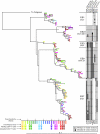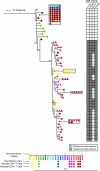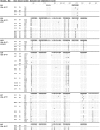Control of HIV-1 in elite suppressors despite ongoing replication and evolution in plasma virus
- PMID: 20444904
- PMCID: PMC2898225
- DOI: 10.1128/JVI.00548-10
Control of HIV-1 in elite suppressors despite ongoing replication and evolution in plasma virus
Abstract
A subset of HIV-1-infected patients known as elite controllers or suppressors (ES) control the virus naturally. We have previously demonstrated sequence discordance between proviral and plasma gag clones in ES, much of which can be attributed to selective pressure from the host (J. R. Bailey, T. M. Williams, R. F. Siliciano, and J. N. Blankson, J. Exp. Med. 203:1357-1369, 2006). However, it is not clear whether ongoing viral replication continues in ES once the control of viremia has been established or whether selective pressure impacts this evolution. The cytotoxic T-lymphocyte (CTL) response in ES often targets Gag and frequently is superior to that of HIV-1 progressors, partially due to the HLA class I alleles B*57/5801 and B*27, which are overrepresented in ES. We therefore examined longitudinal plasma and proviral gag sequences from HLA-B*57/5801 and -B*27 ES. Despite the highly conserved nature of gag, we observed clear evidence of evolution in the plasma virus, largely due to synonymous substitutions. In contrast, evolution was rare in proviral clones, suggesting that ongoing replication in ES does not permit the significant reseeding of the latent reservoir. Interestingly, there was little continual evolution in CTL epitopes, and we detected de novo CTL responses to autologous viral mutants. Thus, some ES control viremia despite ongoing replication and evolution.
Figures





References
-
- Almeida, J. R., D. A. Price, L. Papagno, Z. A. Arkoub, D. Sauce, E. Bornstein, T. E. Asher, A. Samri, A. Schnuriger, I. Theodorou, D. Costagliola, C. Rouzioux, H. Agut, A. G. Marcelin, D. Douek, B. Autran, and V. Appay. 2007. Superior control of HIV-1 replication by CD8+ T cells is reflected by their avidity, polyfunctionality, and clonal turnover. J. Exp. Med. 204:2473-2485. - PMC - PubMed
-
- Andrade, A., J. R. Bailey, J. Xu, F. H. Philp, T. C. Quinn, T. M. Williams, S. C. Ray, D. L. Thomas, and J. N. Blankson. 2008. CD4+ T-cell depletion in an untreated HIV type 1-infected human leukocyte antigen-B*5801-positive patient with an undetectable viral load. Clin. Infect. Dis. 46:e78-e82. - PMC - PubMed
-
- Bailey, J. R., A. R. Sedaghat, T. Kieffer, T. Brennan, P. K. Lee, M. Wind-Rotolo, C. M. Haggerty, A. R. Kamireddi, Y. Liu, J. Lee, D. Persaud, J. E. Gallant, J. Cofrancesco, Jr., T. C. Quinn, C. O. Wilke, S. C. Ray, J. D. Siliciano, R. E. Nettles, and R. F. Siliciano. 2006. Residual human immunodeficiency virus type 1 viremia in some patients on antiretroviral therapy is dominated by a small number of invariant clones rarely found in circulating CD4+ T cells. J. Virol. 80:6441-6457. - PMC - PubMed
Publication types
MeSH terms
Substances
Grants and funding
LinkOut - more resources
Full Text Sources
Medical
Research Materials

